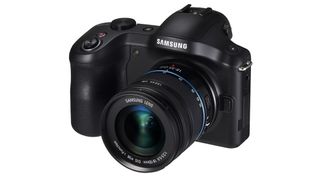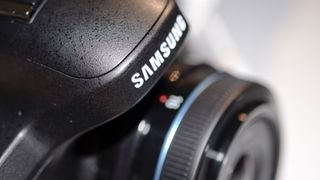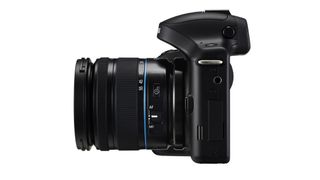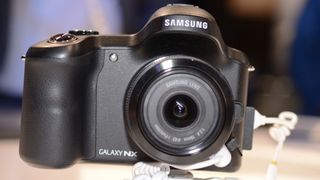Why you can trust TechRadar

Samsung has gone for the DSLR-type styling, rather than flatter, compact style of cameras we've seen from the company of late. A chunky grip makes the camera easier to hold than some of the other NX cameras and helps it to feel secure in the hand, especially when shooting one-handed. That said, the chunky look won't be to everybody's taste, and definitely takes some getting used to.
This isn't really a camera that you can use one handed for long periods of time, due to the size and nature of the screen. You'll need one hand to hold the camera and another to operate the touchscreen.
On the back of the camera there are no buttons, since instead the entire rear is taken up by the extremely large 4.8-inch touchscreen TFT. This is much larger than the usual 3-inch displays found on most compact system cameras and DSLRs, and certainly is a striking look.

The only physical buttons on the camera can be found on top of it, where you'll find the shutter release, a button for lifting the inbuilt flash and a video record button. There's also a dial that can offer a number of different functions, depending on what you're doing with the camera. It can be used to switch between the various modes, such as shutter or aperture priority, or it can be used to jog between different apertures, shutter speeds and so on, once you've selected this parameter on the touchscreen.
By default, scrolling the dial independently will switch between the different exposure modes, but you can also customise the dial to control various key functions such as aperture and sensitivity. Pushing the dial inwards will switch between these different parameters once this mode is set.
By default, the camera switches to sleep mode after 30 seconds. That's quite brief and it takes a little while to warm back up again when you need to use it. With the original firmware installed, we tried switching it to a longer period, but even though it was changed in the menu, it still switched off after 30 seconds - Samsung has now rectified this problem and the sleep timer length can now be changed.

From completely off, the start-up time of the Galaxy NX is pretty slow - being akin to a smartphone or tablet. We're talking about 20 seconds or more to go from off to ready to shoot - not very useful when trying to capture a fleeting moment. To get around this, you can use the camera in sleep mode - Samsung says that battery drain is extremely minimal so it's a good alternative to turning it completely on and off.
Fairly responsive and quick to use, the touchscreen on the back of the camera can be used to control every aspect of the camera's settings. In order to make a change to aperture for instance, you could touch the aperture display on the back of the screen, then swipe with your finger to alter the setting. Initially, the area you need to swipe is quite small, it's easy to be frustratingly inaccurate. Again however, Samsung has enlarged the area to help with this problem. A combination of using the touchscreen and the scrolling dial is probably the most sensible approach.
When using the camera in "professional" mode, touching a cog icon on the screen brings up the menu. The first screen contains a quick way to access various photographic settings, including metering and white balance. When using the camera in "standard" mode, this screen isn't present and you'll have to delve further into the menu, or use the iFunction lens button.

One of the benefits of a touchscreen is the ability to set the focus point anywhere you like quickly and easily. While it's true that you can do that on the Galaxy NX, there initially seemed to be no way of keeping an AF point active with the original version of the camera. Press a point on the screen, take your shot, and hey presto, the point would return to the centre if using Centre AF, or to a different point if using multi-AF. It was pretty annoying having to place the point back to where you wanted it if you're shooting multiple images, for instance when working on a portrait. Happily Samsung has rectified this problem and the active AF point will remain active where you've left it.
Unfortunately though, it is impossible to change the autofocus point when using the viewfinder, meaning you'll need to remove the camera from your eye, set the focus point, then place it back. It's a process that is handled much better by other cameras, including Panasonic's TouchPad AF found on the G5, G6 and GX7 – that allows you to continue to use the touchscreen to set the AF point even when using the viewfinder. Alternatively, other cameras with buttons allow you to change the point while using the viewfinder. It's something that can quickly get very frustrating, so we'd probably recommend using the centre AF point and focusing and recomposing for the majority of your shots.
If you're using one of Samsung's innovative iFunction lenses, then the lack of buttons is less of a problem, since you'll be able to make many changes to aperture, shutter speed and so on via the lens itself. If you're not a fan of touchscreens, though, this really isn't the camera for you.

One difficulty we've found is that when viewing images in playback mode, the virtual delete button is at the top right hand corner of the screen, which means if you're holding the camera by the grip, it can be easy to accidentally hit the delete button. It won't delete since you'll be prompted with a confirmation box, but it is annoying.
If you've been shooting in JPEG and raw format, when playing back images, you'll see two images displayed. This makes it a little tedious to scroll through, and isn't something we've seen on any other recent camera. You also can't display lots of images on screen to navigate though quickly – the best you'll get is a timeline of images at the bottom of the screen, this makes accessing an image you took a while ago pretty time consuming.
To get to the Android portion of the Samsung Galaxy NX, you'll need to tap a Home icon on the screen. From here, it's pretty much like using any other Android-powered device, and you'll find a number of pre-installed options, as well as the ability to add any app you like from the Google Play store.

Initially, it seemed that the camera wouldn't work with some apps. For instance, when using Instagram, the camera wouldn't focus, so you could only really use images you've already taken. It's as if the Android section of the Galaxy NX was entirely separate from the camera section of it, which seems to miss the point a little. Samsung has fixed this problem with the new firmware, making apps such as Instagram more compatible - it will now focus before a shot is taken.
Unlike many of the compact system cameras on the market, Samsung has included an electronic viewfinder (EVF) on the Galaxy NX. In terms of resolution and size, this is a very impressive device, with a sensor included to help produce a seamless transition from using the touchscreen to using the viewfinder - it automatically switches as you bring it to your eye.
The electronic viewfinder itself is very crisp and clear, and it's almost as good as using a traditional optical viewfinder. One of the benefits of using an EVF over an OVF is that you can see any changes you make as they happen, while you can also view images played back, helping you to determine whether or not you've nailed the shot much quicker than having to remove the camera from your eye frequently.
Amy has been writing about cameras, photography and associated tech since 2009. Amy was once part of the photography testing team for Future Publishing working across TechRadar, Digital Camera, PhotoPlus, N Photo and Photography Week. For her photography, she has won awards and has been exhibited. She often partakes in unusual projects - including one intense year where she used a different camera every single day. Amy is currently the Features Editor at Amateur Photographer magazine, and in her increasingly little spare time works across a number of high-profile publications including Wired, Stuff, Digital Camera World, Expert Reviews, and just a little off-tangent, PetsRadar.


